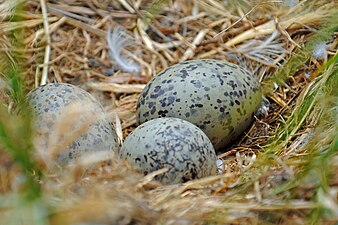| Protection Island National Wildlife Refuge | |
|---|---|
IUCN category IV (habitat/species management area) | |
 Hillside of rhinoceros auklet burrows, Protection Island | |
| Location | Jefferson County, Washington, United States |
| Nearest city | Port Townsend, Washington |
| Coordinates | 48°07′40″N 122°55′35″W / 48.1278714°N 122.9262842°W[1] |
| Area | 659.31 acres (266.81 ha)[2] |
| Established | 1982[3] |
| Governing body | U.S. Fish and Wildlife Service |
| Website | Protection Island National Wildlife Refuge |
Protection Island is an island located in the Strait of Juan de Fuca just north of Discovery Bay in northeastern Jefferson County, Washington, United States. The island has a land area of 379 acres (153 ha). It is a federally protected National Wildlife Refuge; boats are not permitted within 200 yards (180 m) for the safety and health of wildlife on and near the shores. There is only one individual still living on the island not associated with the government. Marty Bluewater has lifetime use of his inholding cabin on the island's southern bluffs.[4][5] The island also houses a caretaker, a volunteer hired by the United States Fish and Wildlife Service, to watch over the island and take care of its many inhabitants. Boat trips from nearby Port Townsend, Washington provide ecotourism visits for viewing wildlife from the adjacent waters.
Spanish explorers were the first Europeans to find the island. In 1790 it was given the name Isla de Carrasco, in honor of Juan Carrasco. It was given its present name by George Vancouver in 1792.[6]
Protection Island National Wildlife Refuge was designated in 1982 to protect the entire island and its coast. Approximately 70 percent of the nesting seabird population of Puget Sound and the Strait of Juan de Fuca nest on the island, which includes one of the largest nesting colonies of rhinoceros auklets in the world and the largest nesting colony of glaucous-winged gulls in Washington. The island contains one of the last two nesting colonies of tufted puffins in the Puget Sound area. It is on the flyway for many migrating birds. Seals (harbor and elephant), sea lions, orcas, and other cetaceans are often seen nearby. About 1,000 harbor seals depend upon the island for a pupping and rest area.[7]
The refuge is closed to visitation to protect the fragile habitat. Visitors may view the island by boat; a 200-yard off-shore buffer is enforced to ensure adult birds are not flushed from their nests.
The waters surrounding the North Olympic Peninsula support five additional refuges: Flattery Rocks, Quillayute Needles, Copalis, Dungeness, and San Juan Islands. Protection Island is managed as part of the Washington Maritime National Wildlife Refuge Complex.
Gallery[edit]
-
Satellite image
-
Birds nesting on Protection Island
-
The refuge is home to 17,000 pairs of nesting rhinoceros auklets
-
Gull nest on the refuge
-
A tufted puffin swims in the refuge
References[edit]
- ^ "Protection Island". Geographic Names Information System. United States Geological Survey, United States Department of the Interior.
- ^ "Annual Report of Lands as of September 30, 2013" (PDF). United States Fish and Wildlife Service.
- ^ "About the Refuge". Protection Island National Wildlife Refuge. U.S. Fish and Wildlife Service.
- ^ "One man is an island". The Seattle Times. 2006-10-19. Retrieved 2017-03-09.
- ^ Fremson, Ruth (2021-06-08). "Protected Habitat, for a Population of One". The New York Times. ISSN 0362-4331. Retrieved 2021-06-08.
- ^ McDowell, Jim (1998). José Narváez: The Forgotten Explorer. Spokane, Washington: The Arthur H. Clark Company. p. 68. ISBN 0-87062-265-X.
- ^ "Protection Island National Wildlife Refuge Profile". U.S. Fish and Wildlife Service.
External links[edit]
- Protection Island National Wildlife Refuge U.S. Fish and Wildlife Service





